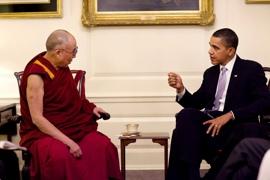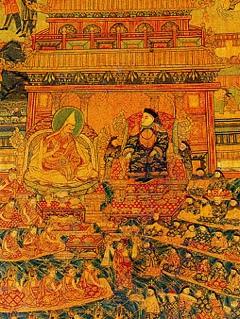
Since President Obama’s meeting with the Dalai Lama on February 18, the details of the closely-watched encounter have been carefully parsed, from the history of the room in which the two men met (the White House Map Room, an apparent indicator that a meeting is private, yet not personal) to the absence of the First Lady (making the meeting more official), and the serving of tea (making it less formal). Even the garbage bags that the Dalai Lama passed on his exit (seen as either incompetence by White House staff or a veiled message to Beijing) and the Dalai Lama’s flip-flops (seen as a metaphor for his policies or a rebuttal to Rupert Murdoch’s claim that the Tibetan leader wears Gucci shoes) were debated.
Yet some of the most interesting details—those that may bear most directly on Obama’s handling of the China-Tibet issue—were missed. Chief among them, perhaps, was that the official White House description of the meeting omitted any mention of religion. It did not even pretend that the two leaders had discussed religion, spirituality, world peace, or any of the other fig-leaves used by European leaders like Gordon Brown to mollify Beijing when committing the offense of meeting with the Dalai Lama. There was also little mention of the fact that the President and his spokesmen did not use the rhetoric about democracy or freedom that in the past has made American leaders (and sometimes the Dalai Lama) look like ideologues.
Instead, administration officials described the meeting as a discussion in plain terms about the political situation in Tibet, thus sending a muscular message to Beijing, which, after all, remains firmly in charge of that territory. The press also downplayed the Dalai Lama’s separate, extended meeting with the Secretary of State, although that could be taken by Beijing as a serious indication that the US views him as a national leader. This perhaps explains why the State Department referred to the Dalai Lama as “a religious and cultural leader,” while the White House described him much more assertively as also “a spokesman for Tibetan rights.”
But what may turn out to have been the most explosive element of ritual emerged only during a minor speech on a quite different topic by the Dalai Lama the following day, and was noticed by a sharp-eared AFP reporter and a Tibetan specialist from VOA: President Obama gave his visitor a gift, mentioned in no official statements—a specially bound volume containing copies of the five letters sent by Roosevelt and Truman directly to the young Dalai Lama when he ruled what was, in practice, an independent country. It doesn’t take a Ph.D. to guess how that went down in Beijing.
Still, Chinese leaders must have relished the visual record of the event. The subtext of the single photograph of the meeting, released by the White House, was clear to anyone familiar with Buddhist, Asian or Chinese iconography, literate or not: it showed the President speaking to the Dalai Lama with his right hand raised, much as in the teaching mudra used to show the Buddha preaching to his disciples; while the Dalai Lama, like an attentive pupil, has turned to listen, so that his eyes cannot be seen.

The most famous visual record of any encounter between the Tibetan pontiff and a worldly ruler is the mural in the Potala Palace that depicts the 5th Dalai Lama meeting the Qing Emperor Shunzhi in 1653. The Chinese authorities misread that powerful image in the past: they reproduced it in the 1980s in innumerable postcards and propaganda books because it shows the Emperor sitting on a slightly higher throne than his Tibetan visitor—until they discovered that all Tibetans and any Buddhist could see that the mural shows that the Dalai Lama has his right hand raised and is clearly teaching his imperial disciple. This time, it is the Emperor who is preaching.
But even for the most secular Tibetans, the White House photograph is puzzling: it shows the President with his legs crossed, unthinkable casualness for a Chinese or Tibetan leader. And then there’s the tea: the photograph shows a tea-cup and a cookie in front of the Dalai Lama, while the President has neither, an unmistakable sign that the President did not deign to drink with his visitor. In case anyone thinks that drinking tea together is not important, they need to reread their copy of the Dukula, the 5th Dalai Lama’s autobiography, in which he describes his 1653 meeting. Immediately after noting that the Emperor’s throne was slightly higher than his, he writes:
gsol ja byung ba’i dus sngon la ‘thung gsungs kyang de ‘dra mi ‘gab zhus pas dus mnyam du ‘thang gnang ba sogs mthong gzos shin tu che ba mdzad
When tea was served, the king asked me to drink first. I replied that this would not be proper. So he suggested we drink at the same time. He showed much respect.
That’s something you won’t read in Beijing’s accounts of the meeting, just as you won’t find the contemporary descriptions—unthinkable to those brought up on the Chinese myth that Tibetan leaders had to kowtow to the Emperor—of Shunzhi descending from his throne to meet the Dalai Lama, walking “approximately four bow-lengths” (about 30 feet) towards him and taking him by the hand. Consider The Secret History of the Potala Palace, the famous feature film produced in Lhasa in 1989, in which the historic 1653 meeting was recreated by contemporary Tibetan actors without a kowtow: it has been banned by Beijing since its first showing.
Advertisement
The White House photograph’s symbolism was presumably unintentional, but it carries another echo from the past: American officials tried to tone down Dalai Lama meetings once before, and it did not work out well. In 1908, the great Tibetologist William Woodville Rockhill, then the US envoy in Beijing, insisted that the 13th Dalai Lama reverse the precedent of 1653 and show submission to the Imperial throne probably because the US sought a Chinese alliance in order to deny the British market access to the Qing domains. The 13th compromised and went down only on his knees, not unlike Lord Macartney, sent to China in 1793 as the first British envoy, who had gone down on one knee before the Emperor Qianlong. But Rockhill’s efforts at staging conciliation failed: within 2 years the Qing had sent an invasion force to Lhasa, and three years later the 13th Dalai Lama, disappointed with misjudged American conciliation and increasingly close to the British, declared Tibet to be independent.
His successor, the 14th Dalai Lama, travels the world constantly scoring symbolic victories and will be unconcerned about the President’s teaching mudra or the single cup of tea. Inside Tibet, however, people might fear that the shade of Rockhill is whispering equivocating advice in the corridors of the White House. This would seem a little unjust if the other details are considered (though the garbage bags don’t help). But it raises the central and as yet unanswered question, which is whether Obama’s long-awaited initial foray into the Tibet issue will bring Beijing, masters of the land, any closer to settling with their Tibetan neighbors, masters of symbolic ritual.


